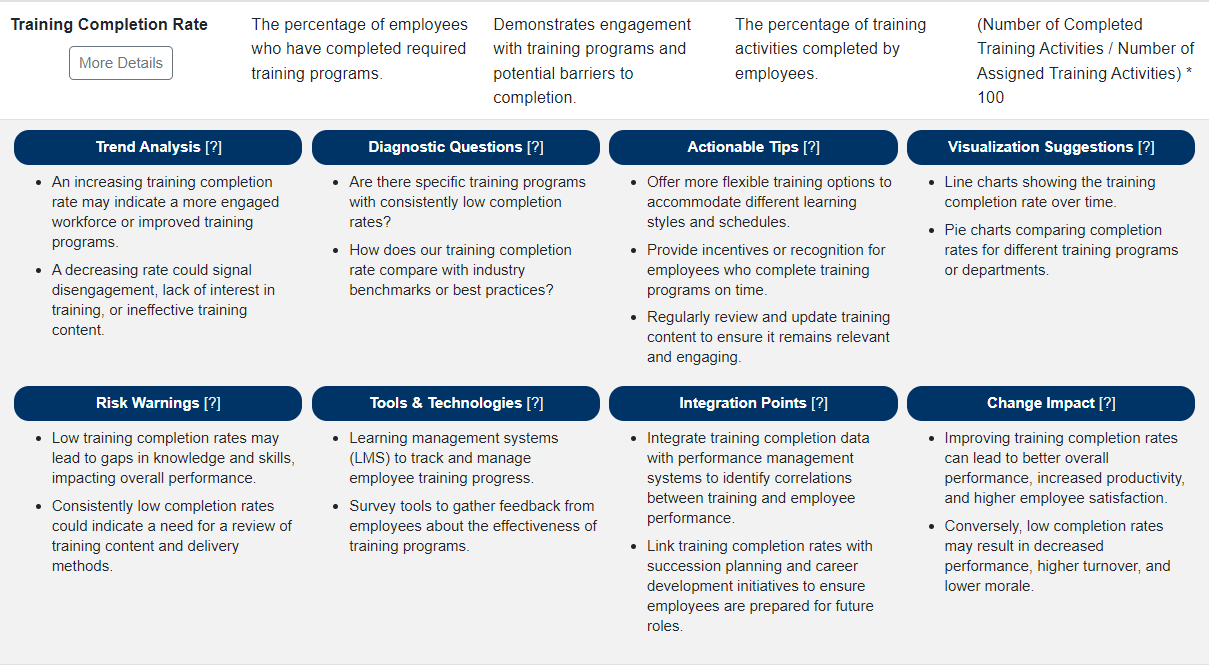Editor's Note: Take a look at our featured best practice, Cost Segregation Study: Multiple Property Class Analysis (Excel workbook). Accountants, accounting firms, and real estate property owners can all benefit from this cost segregation study (CSS) template. It makes the estimated benefit easy to figure out and has flexible assumptions for high level or detailed segregation analysis. You get a summary of cost [read more]
KPI Management: Learning and Development (L&D) KPIs and Training KPIs
* * * *

A Learning Organization is characterized by its commitment to fostering an inclusive culture of continuous improvement, knowledge sharing, and adaptive learning. This approach not only enhances individual employee skills but also cultivates a collaborative and resilient organizational culture. The benefits of becoming a Learning Organization extend beyond individual and organizational growth, contributing to increased employee engagement, higher retention rates, and sustained competitive advantage.
This article aims to explore the significance of transforming into a Learning Organization within the context of strategic planning and performance measurement. By examining Key Performance Indicators (KPIs) associated with Learning and Development (L&D) and Training, we seek to demonstrate how organizations can leverage these metrics to inform decision-making, enhance training effectiveness, and measure the ROI of development initiatives.
Through this analysis, executives and senior managers will gain insights into optimizing L&D/Training strategies to drive organizational performance and adapt to changing industry demands, thereby realizing the full potential of becoming a Learning Organization.
Importance of Learning & Development (L&D) and Training
In an era marked by rapid technological advancements and shifting market dynamics, the L&D/Training function has emerged as a cornerstone of organizational resilience and innovation. Effective L&D/Training programs are essential for equipping employees with the necessary skills to navigate new technologies, processes, and business models.
Moreover, as organizations increasingly recognize the link between employee development, satisfaction, and retention, L&D/Training initiatives have become pivotal in attracting and retaining top talent.
Challenges to Implementing Effective L&D and Training Programs
Organizations face numerous challenges in implementing effective L&D/Training programs, including aligning training with business objectives, quantifying the impact of development initiatives, and ensuring training relevancy in the face of rapidly changing skill requirements. Additionally, the transition to remote and hybrid work models has necessitated the adaptation of training methodologies to virtual environments.
KPIs for L&D/Training address these challenges by providing a framework for evaluating training effectiveness, measuring learner engagement, and assessing the contribution of training to organizational goals. By focusing on these KPIs, companies can navigate the complexities of employee development, ensuring their workforce remains agile, skilled, and motivated in an ever-changing business landscape.
Top 10 Learning & Development and Training KPIs
For Learning and Development (L&D)/Training, focusing on impactful KPIs is crucial for fostering a Learning Organization and ensuring the workforce is equipped to meet current and future challenges. Here are the top 10 KPIs essential for effective L&D/Training. These KPIs are selected from the Flevy KPI Library, a robust database of over 15,000+ KPIs.
1. Training Completion Rate
- Definition: The percentage of enrolled employees who complete the training programs.
- Relevance: Indicates employee engagement with learning opportunities and the accessibility of training programs.
2. Employee Satisfaction with Training
- Definition: Measures how satisfied employees are with the training content, delivery, and applicability.
- Relevance: High satisfaction rates can correlate with higher motivation to apply learned skills on the job, impacting overall productivity.
3. Knowledge Retention Rate
- Definition: The extent to which employees retain and recall information and skills acquired through training over time.
- Relevance: Essential for assessing the effectiveness of training programs and their long-term impact on employee performance.
4. Certification Completion Rate
- Definition: The percentage of employees who achieve certification after completing training programs.
- Relevance: Reflects the quality and relevance of training, contributing to professional development and compliance.
5. Learning and Development ROI
- Definition: The return on investment for L&D initiatives, calculated by comparing the benefits (such as performance improvements) to the costs.
- Relevance: Provides insight into the financial value generated by training and development activities.
6. E-Learning Utilization Rate
- Definition: The degree to which employees engage with digital learning resources and platforms.
- Relevance: Indicates the effectiveness and accessibility of online learning in supporting continuous development.
7. Leadership Development Participation
- Definition: The number of employees participating in leadership development programs.
- Relevance: Critical for succession planning and ensuring a pipeline of future leaders.
8. Employee Progression Post-Training
- Definition: The advancement or improvement in employee performance, responsibilities, or position following participation in L&D activities.
- Relevance: Demonstrates the impact of training on career development and organizational growth.
9. Compliance Training Completion Rate
- Definition: The percentage of required compliance training courses successfully completed by employees.
- Relevance: Vital for meeting regulatory requirements and minimizing legal risks.
10. Cross-Functional Training Participation
- Definition: The extent to which employees participate in training programs outside their primary job functions.
- Relevance: Encourages skill diversity, innovation, and flexibility within the workforce, supporting the Learning Organization model.
To dig deeper into any of these KPIs, we invite you to explore the Flevy KPI Library, which allows you to drill down into 12 attributes for each KPI in the database. Here is an example for our top ranked KPI, Training Completion Rate:
Case Studies and Success Stories
Transforming Leadership with Development Programs
A multinational corporation identified a gap in its leadership pipeline and aimed to address it through “Leadership Development Participation.” The objective was to cultivate a new generation of leaders equipped to navigate the complexities of global business.
The organization launched a comprehensive leadership development program, incorporating mentorship, strategic project assignments, and leadership workshops. Participation was tracked as a key performance indicator to gauge engagement and commitment.
Outcome: The initiative led to a significant increase in leadership development participation, with over 75% of targeted employees completing the program within the first year. Subsequently, the company witnessed notable improvements in “Employee Progression Post-Training,” with many participants advancing to leadership roles, contributing fresh perspectives and driving innovation.
Lessons Learned: Investing in leadership development is crucial for organizational sustainability and growth. By making leadership development participation a priority and closely monitoring it, companies can ensure a robust pipeline of skilled leaders ready to take on future challenges.
Boosting Compliance through Targeted Training
Facing regulatory challenges, a financial services firm prioritized the “Compliance Training Completion Rate” to ensure all employees were informed of and compliant with industry regulations and standards.
The firm developed a mandatory, interactive compliance training program, accessible via an e-learning platform to accommodate diverse schedules and learning preferences. The completion rate served as a critical metric for assessing employee engagement and adherence to compliance requirements.
Outcome: The focused approach resulted in a 100% compliance training completion rate within the stipulated timeframe, significantly reducing compliance-related risks and enhancing the firm’s reputation for regulatory adherence. Additionally, the “E-Learning Utilization Rate” KPI revealed high engagement levels with the digital learning platform, indicating its effectiveness in delivering essential training.
Lessons Learned: Ensuring high completion rates for compliance training is essential for mitigating risks and maintaining regulatory compliance. Digital training platforms can offer flexible and effective means to achieve these goals, provided they are monitored through relevant KPIs to ensure engagement and effectiveness.
Additional Resources and Further Reading
Foremost, if you are in the process of selecting or refreshing your Human Resource Management KPIs, take a look at the Flevy KPI Library. With over 15,000+ KPIs, our KPI Library is one of the largest databases available. Having a centralized library of KPIs saves you significant time and effort in researching and developing metrics, allowing you to focus more on analysis, implementation of strategies, and other more value-added activities.
Here are other KPI Strategy and KPI Management articles we’ve published:
- Principles of KPI Selection. This article breaks down the 8 guiding principles to KPI selection and provides several case studies on how to use these principles in practice.
- Principles of KPI Maintenance. It’s important to recognize that as market conditions and strategic objectives evolve, so too must the KPIs. This article provides a disciplined approach to maintaining KPIs.
- KPI Dashboard Design & Visualization. Learn the art and science of designing KPI dashboards, including types of data visualization and how to choose among them.
- Anatomy of a Strong KPI. Learn what makes a KPI effective, discussing the characteristics of KPIs that are most impactful and how they can drive strategic business decisions.
- 10 Common Pitfalls in KPI Implementation. Learn how to identify and remediate the 10 most common pitfalls in KPI implementation. If left unfixed or as unknowns, these pitfalls can have disastrous, long-term impacts on the organization.
- KPIs and Organizational Alignment . This article discusses the concepts of strategic, tactical, and operational KPIs; as well as balancing individual, team, and organizational objectives.
- Integrating KPIs into Employee Performance. This article discusses 5 methods for integrating KPIs into individual performance metrics; and includes several case studies.
- Integrating KPIs into the Organizational Culture. This article breaks down 4 strategies for embedding KPIs into the Corporate Culture; also includes several case studies.
- Future-Proofing KPIs. Understand how to “future-proof” KPIs by understanding the impacts of emerging market trends, emerging technologies, and evolving consumer behaviors on KPIs.
- KPIs and Digital Transformation. All organizations are undergoing Digital Transformations. Learn how to define, select, and implement relevant Digital Transformation KPIs.

Do You Want to Implement Business Best Practices?
You can download in-depth presentations on 100s of management topics from the FlevyPro Library. FlevyPro is trusted and utilized by 1000s of management consultants and corporate executives.
For even more best practices available on Flevy, have a look at our top 100 lists:
- Top 100 in Strategy & Transformation
- Top 100 in Digital Transformation
- Top 100 in Operational Excellence
- Top 100 in Organization & Change
- Top 100 Management Consulting Frameworks
These best practices are of the same as those leveraged by top-tier management consulting firms, like McKinsey, BCG, Bain, and Accenture. Improve the growth and efficiency of your organization by utilizing these best practice frameworks, templates, and tools. Most were developed by seasoned executives and consultants with over 20+ years of experience.
Readers of This Article Are Interested in These Resources

|
|
145-slide PowerPoint presentation
|
|
Excel workbook
| |||
About Flevy Management Insights
Top 10 Recommended Documents














